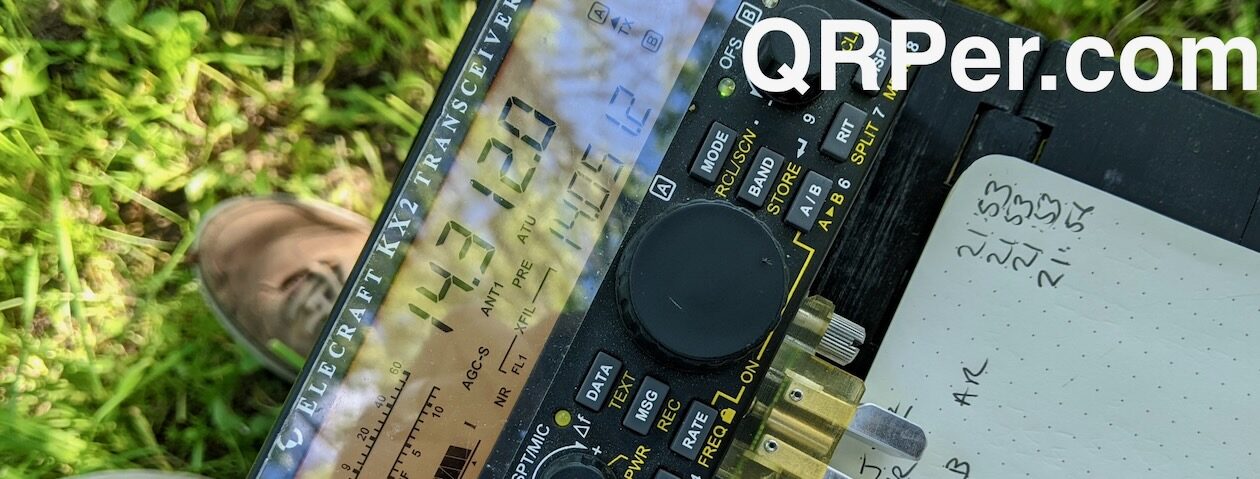Many thanks to HUAQIANG Gu (BD4LB) who shares the following information about his homemade L-Match. Note that BD4LB doesn’t speak English, and I don’t speak Chinese, so the following was machine-translated via Google Translate:
Homemade L-Match for Field Operating
by HUAQIANG Gu (BD4LB)
L-MATCH has a simple structure and is easy to make.
It is mainly composed of a coil and an adjustable capacitor.
- The coil is made of copper wire with a diameter of 1.8mm, and the outer diameter of the coil is 50mm.
- The capacitance of the thin film adjustable capacitor is 0pF–200pF.
- When using, a balanced ground wire needs to be installed.
(Different bands, multiple quarter-wave length wires, and together. I use a row of wires. For example: two balanced ground wires 10 meters and 5 meters long, respectively 40 meters band and 20 meters band balanced ground wire.)
After many outdoor communications, I adjusted the end-fed antenna. The length of the radiator was 10 meters, which was appropriate.
One end of it is hung from the top of a 6-meter-long fiberglass fishing rod. On the other end, connect the red binding post of L-match.
Balance the ground wire and connect it to the black binding post. Spread it out on the ground.
 The L-match is placed on the ground and connected to the HS1B or KVE60C antenna analyzer using a one meter long 50-3 coaxial cable. (This reduces the length and weight of the coaxial cable.)
The L-match is placed on the ground and connected to the HS1B or KVE60C antenna analyzer using a one meter long 50-3 coaxial cable. (This reduces the length and weight of the coaxial cable.)
When using an inverted V antenna, the length of the coaxial cable needs to be at least 8 meters.
My outdoor communication is mainly on the top of a hill in the park, or on the beach by the sea.
On the beach, there is plenty of space. In addition to setting up end-fed antennas, you can also set up inverted V antennas.
On the top of the mountain in the park, the space is limited, and it is difficult to deploy the 20-meter-long antenna oscillator. Only 10-meter end-fed antennas can be used.
After fixing the fishing rod, installing the antenna radiator and balanced ground wire, first connect the antenna analyzer KVE60C.
Use copper alligator clips to clip on the coil and adjust the adjustable capacitance to minimize the standing wave ratio of 7.023 MHz.
(Change different coil taps, adjust the adjustable capacitor, and try several times.)
I carry a compass to adjust the transmitting direction of the end-fed antenna. I won’t get lost.
The actual communication effect is quite good.
In the 40-meter band, it is suitable for short-distance communication within 800 kilometers.
In the 20-meter band, it is suitable for communication within 1000-2000 kilometers.






Hello Huaqiang, thank you for your post.
It is fascinating to see how things are done across the world! I’m curious what the white spool is – multiconductor ribbon for the radials? Is it on some kind of winder? Also curious about what look like disc capacitors outboard of the radio. What are they for? Good luck and good DX!
72, Scott VO1DR
Hi! Scott .
You are right,it is disc capacitors .
72!
gu
The white spool looks like a sports open reel measuring tape winder, with multi-conductor ribbon cable winded on it. I recalled my PE teachers at school by looking at this. 🙂
Yes!
Nice article! Translators have clearly come a long way! Thanks for making this story available to all of us. Bravo!
Hi Huaqiang,
Can you tell us more about your coil and which capacitor did you use ?
Tks es hpe cuagn.
72
Didier de F8GLE (did in Cw)
Hi Dider
plastic variable capacitor (0—200pF)
diameter of Coil is 50mm.
Ok, tks, can you tell us wich inductance is your coil ? About 10 microhenries ?
Have a Nice day.
72
Didier de F8GLE (did in cw)
About 3micro-henries.
Tks, so much and have a Nice day.
72
Didier de F8GLE (did in cw)
Many years ago when I was doing a lot of HFpack I built a small L-network tuner into a small plastic box using a tapped toroidal inductor, a variable capacitor, and a rotary switch. Input was via a SO-239 mounted directly on the box, which then plugged directly into the SO-239 on my FT-817 via a PL-259/259 barrel connector. Output was via banana plugs for the random wire antenna and counterpoise. I would “wear” my FT-817 using the shoulder strap around my neck and wrap the antenna wire around a 20 foot telescoping fiberglass fishing pole so I could walk with it. That setup “worked a treat”!
Hi Huaqiang,
Very nice DIY project, thank you for sharing!
The 4th photo has a plastic variable capacitor (塑料可变电容) and an air variable capacitor (空气可变电容), probably they’re in parallel to each other, but why the photo says “No good”?
Google translation is 99% good enough. I can help translate between Chinese and English if needed. I was BG1KG but never on-air in China. My current KG6YJ email address on QRZ.com is good.
72!
de KG6YJ, Jun
To make a better L-Zmatch for QRP ,one plastic variable capacitor(0–200pF) is good enough.
Hi Huaqiang,
Your DIY project very good. The L-match look simple. Can you share the L-match data?